I am moved to write these blog posts when something really irks me. It takes a while sometimes for the irritation to bother me enough to break the barrier of behaving politely, and to actually say what I think about a situation. Think of this as my “sheet caking” (thanks to Tina Fey).
One of my Earth School students, who is now in college studying environmental science, recently recommended a book to me, “The Nature Fix,” by Florence Williams. I spent the past few days fuming every time I read a few pages. I’d have to yell at the book and throw it down for a while before I could get the courage to pick it up again and read some more. It is an important book. The gist of it is, that nature causes well-being in humans. The scientific studies that the book is filled with and the statistics that it uses as proof are all very impressive and fascinating. But I cannot get past wondering why we need a book or medical scientific research to tell us what we already instinctively know?
The fact seems to be, at least in our current age, that we don’t all know, and some of us won’t believe it unless there is scientific proof through clinical studies to show without doubt that humans benefit from time spent in nature. But please indulge me for a few minutes, while I dig into this sheet cake.
Whole sets of studies involve volunteers or prisoners or business people who are exposed in the lab to stressful prompts (like public speaking or mental math problems) with electrodes stuck to their bodies to prove they are experiencing stress. Then they are shown either a blank wall, or a photo of nature, or an open window, and the studies show that the window that looks out onto nature causes the most relaxation. Ok, that’s great, but here is where it goes next. Because the image of nature is almost as relaxing as real nature itself (not quite, but it’s better than a blank wall), there are people working on creating virtual reality experiences to take the place of real nature, where you can sit in a cinder block and concrete room and experience nature in order to de-stress.
Why would anyone want to do this? Because explains one Ph.D., “This way, you can enjoy your own living room and it’s relatively cheap. You can go to Hawaii without the bugs and the jet lag.” That’s when I threw the book down again.
For those who have ever been to the extraordinary and magical and powerful land of Hawaii, you know of the awe and wonder caused by the Hawaiian landscape, which can only really be experienced by being immersed in it. Hawaii is a place where once-in-a-lifetime experiences happen every minute, from the ocean vistas that include whales breaching, to the giant curls of the turquoise waves on the beaches, to the intensity of the glow of a lava flow, to the appearance of double rainbows arching over volcanic mountains – the last thing that you are thinking about is bugs or jet lag. All you are thinking about is how well you feel, how joyful, how inspired, and how incredibly lucky you are to be there.
 My work with children from urban environments teaches me that children need to immerse themselves in nature in order to feel the benefits, as well as to confront their fears. One of the Central Harlem schools I work with has no windows at all in the building. There is no natural light or fresh air, and children are bused to and from the school building. The first graders in this school are able to spell words aloud in their classroom that I never imagined a 6 year old could spell. They can read and write and do math at very advanced levels. But when they come to the farm to work with me in nature, if they encounter so much as a ladybug, many of them shriek with terror, and I have held and comforted children who are sobbing and shaking at the sight of these tiny, harmless, (and actually kind of cute) little insects. But after the children have spent a day with their entire bodies in nature, all of their senses engaged, they describe to me how happy they feel, and I can see their confidence glow, as they tell me, “I faced my fears.”
My work with children from urban environments teaches me that children need to immerse themselves in nature in order to feel the benefits, as well as to confront their fears. One of the Central Harlem schools I work with has no windows at all in the building. There is no natural light or fresh air, and children are bused to and from the school building. The first graders in this school are able to spell words aloud in their classroom that I never imagined a 6 year old could spell. They can read and write and do math at very advanced levels. But when they come to the farm to work with me in nature, if they encounter so much as a ladybug, many of them shriek with terror, and I have held and comforted children who are sobbing and shaking at the sight of these tiny, harmless, (and actually kind of cute) little insects. But after the children have spent a day with their entire bodies in nature, all of their senses engaged, they describe to me how happy they feel, and I can see their confidence glow, as they tell me, “I faced my fears.”
These children from Central Harlem always tell me that their favorite activity each time they visit the farm is to roll down the grassy hillside. We do this near the end of every trip, because afterwards, many of them are coughing and wheezing and itching, and they tell me, “I am allergic to grass.” Is it because they haven’t encountered actual grass with their bodies before? Should these children be exposed only to virtual grass? Allow me to take another huge bite of the sheet cake.
 Woody Allen is quoted as saying, “I love nature, I just don’t want to get any of it on me.” It’s a funny line, and very appropriate for a neurotic New York comedian, but there is some truth in it for a lot of people. Teenagers from the suburbs, who have access every day to nearby nature, simply don’t go out into the woods. I work with local students who don’t want to get their sneakers dirty, never mind their hands. They put plastic bags over their shoes to work with me at the farm, and they will even put plastic gloves over their hands before planting seeds, and they totally refuse to sit down on the grass.
Woody Allen is quoted as saying, “I love nature, I just don’t want to get any of it on me.” It’s a funny line, and very appropriate for a neurotic New York comedian, but there is some truth in it for a lot of people. Teenagers from the suburbs, who have access every day to nearby nature, simply don’t go out into the woods. I work with local students who don’t want to get their sneakers dirty, never mind their hands. They put plastic bags over their shoes to work with me at the farm, and they will even put plastic gloves over their hands before planting seeds, and they totally refuse to sit down on the grass.
“The Nature Fix” suggests that if there is enough scientific proof that nature is beneficial to humans, then perhaps doctors will be able to prescribe walks in the woods to stressed out patients (according to the research, it’s not enough to just go to a city park – to really relax, one has to get deeper into nature). In countries like Japan and South Korea, this has already begun and there are schools of Forest Medicine, and people pay money to be taken into the woods for “Forest Therapy.” City dwellers take the essential oil from the trees and put these into infusers so they can inhale this while they sleep. I take a huge piece of sheet cake and shove it into my mouth.
Are we really so disconnected as all this? It seems so. To her credit though, the author of “The Nature Fix” is actually made nauseous by the virtual reality nature experience she tries. Even with all the technology being developed to try to help people feel closer to nature indoors, she makes the point that allows me to breathe, and gently place the book down for now: “There’s a better solution: go outside.”
Exactly.
This week I worked with kindergarten age children who are from impoverished circumstances in a suburban environment. I asked them, “Where does water come from?” They looked at me blankly at first, then one boy said, “From pipes.” That was a reasonable answer, and so I asked, “Where does the water come from before it goes into the pipes?” No one responded, then the same boy said, “From the sewer.” That was a pretty cool perception for such a young age. But did they know where water came from in the first place? They didn’t. I gently suggested, “Everything comes from nature,” and I hinted my eyes upwards. They looked up in the air and said, “Ohhh, the sky!” It took a while to get to clouds, but fair enough.
 We went into the woods to follow the water cycle from clouds to gutters to wetland ponds to streams to reservoirs, and for two hours, the children were completely immersed in nature. I coaxed them to jump from rock to rock, to balance on logs and tree roots, to put their hands in the water we were following. “The stream disappeared!” The same boy exclaimed. “It became the lake!” he shouted with excitement. On the way back out of the forest, I asked the teachers if they ever take the children into the woods? No, they had never done so before.
We went into the woods to follow the water cycle from clouds to gutters to wetland ponds to streams to reservoirs, and for two hours, the children were completely immersed in nature. I coaxed them to jump from rock to rock, to balance on logs and tree roots, to put their hands in the water we were following. “The stream disappeared!” The same boy exclaimed. “It became the lake!” he shouted with excitement. On the way back out of the forest, I asked the teachers if they ever take the children into the woods? No, they had never done so before.
I don’t need the scientific research to tell me what’s needed for a child’s well-being, I see it every day. My dedication to immerse children in nature and use all of their senses to experience it is now redoubled, thanks to “The Nature Fix.” I definitely recommend reading the book, just have a huge piece of sheet cake with you while you do.




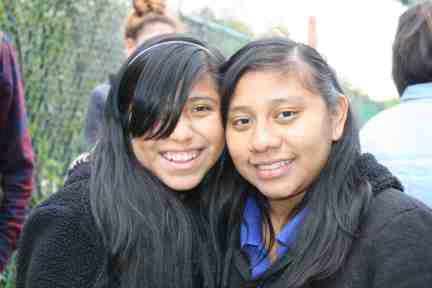



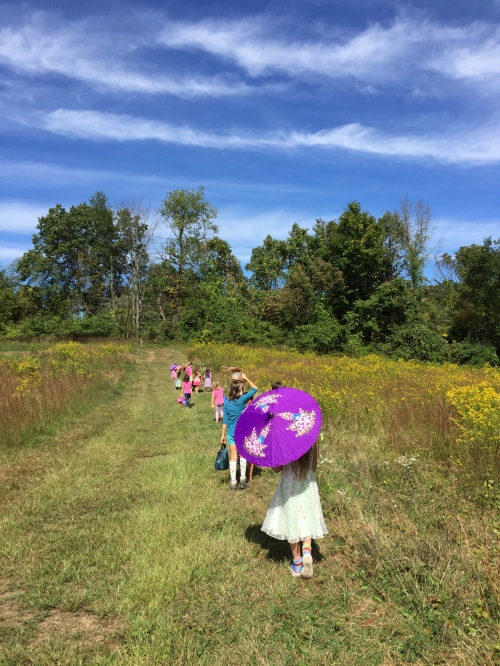
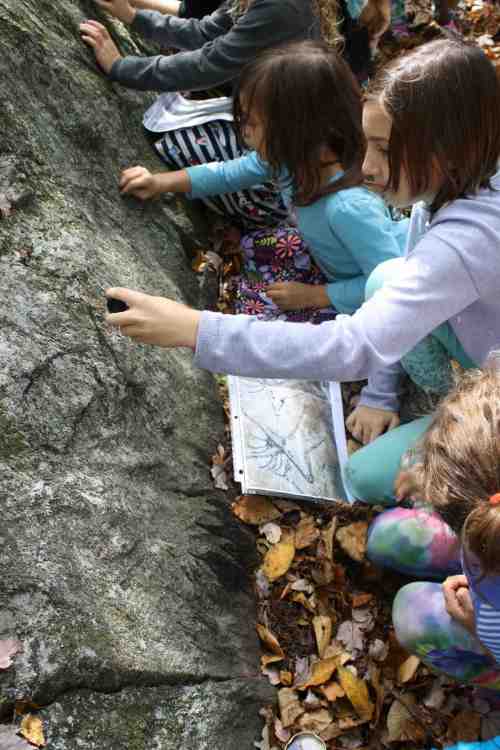
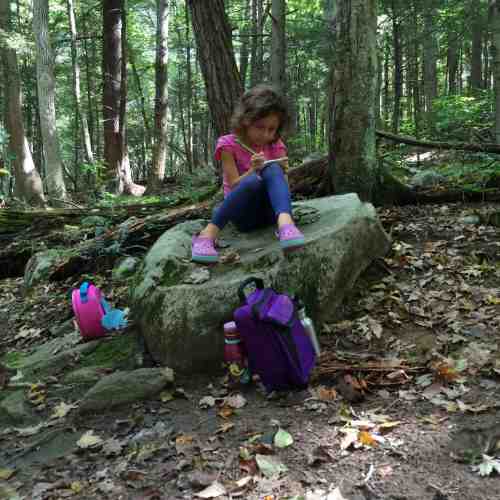


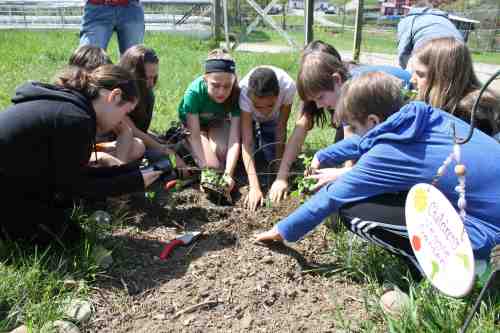





 These are children who really need services given to them; they probably don’t really need to be concerned about giving to others. Do they? Somehow the act of putting one’s hands in the soil and finding a worm and considering what to do with it, removing rocks that are in the way, making a bed for the flowers and tucking them in gently, something about this is analogous, and causes well-being. The same thing is true of harvesting, choosing flowers, putting them together in a bouquet just so, putting them in a jar of water. I see that the entire act of planting, weeding, watering, mulching, harvesting just makes humans feel good. Is that enough, just to feel better?
These are children who really need services given to them; they probably don’t really need to be concerned about giving to others. Do they? Somehow the act of putting one’s hands in the soil and finding a worm and considering what to do with it, removing rocks that are in the way, making a bed for the flowers and tucking them in gently, something about this is analogous, and causes well-being. The same thing is true of harvesting, choosing flowers, putting them together in a bouquet just so, putting them in a jar of water. I see that the entire act of planting, weeding, watering, mulching, harvesting just makes humans feel good. Is that enough, just to feel better?

 It’s a weekday morning and I am working with the refugee children from Central America. I always hesitate to call these “children,” because they are already young men and women, and they are so much more like adults than children their own age in the suburbs of Westchester. But sometimes, when they encounter something new, they are children again. This morning it is dandelions.
It’s a weekday morning and I am working with the refugee children from Central America. I always hesitate to call these “children,” because they are already young men and women, and they are so much more like adults than children their own age in the suburbs of Westchester. But sometimes, when they encounter something new, they are children again. This morning it is dandelions. It’s really important to me that the children from Honduras, El Salvador and Guatemala don’t lose their connection to the land and farming, even in a backyard sense. They mostly come from rural areas and many have been farming already, keeping chickens, eating local and seasonal as a natural process. Now that they are in North America, I see how they get immediately exposed to fast food and junk food and packaged, processed, unnatural and unhealthy foods – that’s what the government gives them for free.
It’s really important to me that the children from Honduras, El Salvador and Guatemala don’t lose their connection to the land and farming, even in a backyard sense. They mostly come from rural areas and many have been farming already, keeping chickens, eating local and seasonal as a natural process. Now that they are in North America, I see how they get immediately exposed to fast food and junk food and packaged, processed, unnatural and unhealthy foods – that’s what the government gives them for free.


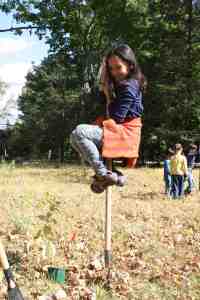


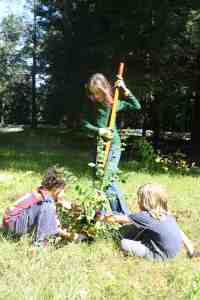
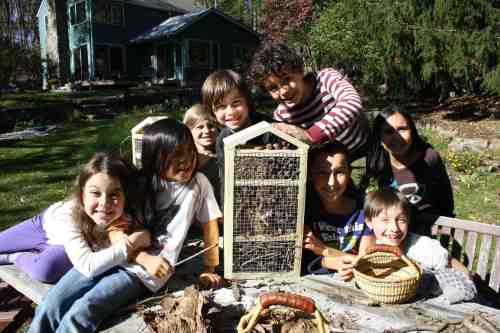


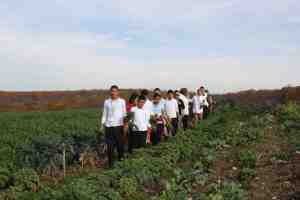






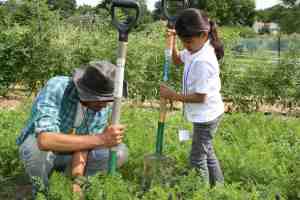







You must be logged in to post a comment.